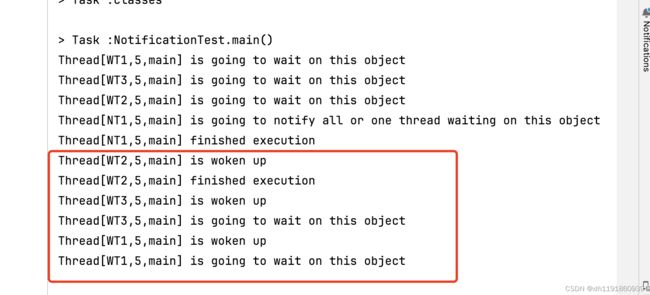- 移动端城市区县二级联动选择功能实现包
good2know
本文还有配套的精品资源,点击获取简介:本项目是一套为移动端设计的jQuery实现方案,用于简化用户在选择城市和区县时的流程。它包括所有必需文件:HTML、JavaScript、CSS及图片资源。通过动态更新下拉菜单选项,实现城市到区县的联动效果,支持数据异步加载。开发者可以轻松集成此功能到移动网站或应用,并可基于需求进行扩展和优化。1.jQuery移动端解决方案概述jQuery技术简介jQuery
- 深入解析JVM工作原理:从字节码到机器指令的全过程
一、JVM概述Java虚拟机(JVM)是Java平台的核心组件,它实现了Java"一次编写,到处运行"的理念。JVM是一个抽象的计算机器,它有自己的指令集和运行时内存管理机制。JVM的主要职责:加载:读取.class文件并验证其正确性存储:管理内存分配和垃圾回收执行:解释或编译字节码为机器指令安全:提供沙箱环境限制恶意代码二、JVM架构详解JVM由三个主要子系统组成:1.类加载子系统类加载过程分为
- JVM 内存模型深度解析:原子性、可见性与有序性的实现
练习时长两年半的程序员小胡
JVM深度剖析:从面试考点到生产实践jvmjava内存模型
在了解了JVM的基础架构和类加载机制后,我们需要进一步探索Java程序在多线程环境下的内存交互规则。JVM内存模型(JavaMemoryModel,JMM)定义了线程和主内存之间的抽象关系,它通过规范共享变量的访问方式,解决了多线程并发时的数据一致性问题。本文将从内存模型的核心目标出发,详解原子性、可见性、有序性的实现机制,以及volatile、synchronized等关键字在其中的作用。一、J
- Java | 多线程经典问题 - 售票
Ada54
一、售票需求1)同一个票池2)多个窗口卖票,不能出售同一张票二、售票问题代码实现(线程与进程小总结,请戳:Java|线程和进程,创建线程)step1:定义SaleWindow类实现Runnable接口,覆盖run方法step2:实例化SaleWindow对象,创建Thread对象,将SaleWindow作为参数传给Thread类的构造函数,然后通过Thread.start()方法启动线程step3
- SpringMVC的执行流程
1、什么是MVCMVC是一种设计模式。MVC的原理图如下所示M-Model模型(完成业务逻辑:有javaBean构成,service+dao+entity)V-View视图(做界面的展示jsp,html……)C-Controller控制器(接收请求—>调用模型—>根据结果派发页面2、SpringMVC是什么SpringMVC是一个MVC的开源框架,SpringMVC=Struts2+Spring,
- JAVA接口机结构解析
秃狼
SpringBoot八股文Javajava学习
什么是接口机在Java项目中,接口机通常指用于与外部系统进行数据交互的中间层,负责处理请求和响应的转换、协议适配、数据格式转换等任务。接口机的结构我们的接口机的结构分为两个大部分,外部接口机和内部接口机,在业务的调度上也是通过mq来实现的,只要的目的就是为了解耦合和做差异化。在接口机中主要的方法就是定时任务,消息的发送和消费,其他平台调用接口机只能提供外部接口机的方法进行调用,外部接口机可以提供消
- 最新阿里四面面试真题46道:面试技巧+核心问题+面试心得
风平浪静如码
前言做技术的有一种资历,叫做通过了阿里的面试。这些阿里Java相关问题,都是之前通过不断优秀人才的铺垫总结的,先自己弄懂了再去阿里面试,不然就是去丢脸,被虐。希望对大家帮助,祝面试成功,有个更好的职业规划。一,阿里常见技术面1、微信红包怎么实现。2、海量数据分析。3、测试职位问的线程安全和非线程安全。4、HTTP2.0、thrift。5、面试电话沟通可能先让自我介绍。6、分布式事务一致性。7、ni
- 图论算法经典题目解析:DFS、BFS与拓扑排序实战
周童學
数据结构与算法深度优先算法图论
图论算法经典题目解析:DFS、BFS与拓扑排序实战图论问题是算法面试中的高频考点,本博客将通过四道LeetCode经典题目(均来自"Top100Liked"题库),深入讲解图论的核心算法思想和实现技巧。涵盖DFS、BFS、拓扑排序和前缀树等知识点,每道题配有Java实现和易错点分析。1.岛屿数量(DFS遍历)问题描述给定一个由'1'(陆地)和'0'(水)组成的二维网格,计算岛屿的数量。岛屿由水平或
- 【异常】使用 LiteFlow 框架时,提示错误ChainDuplicateException: [chain name duplicate] chainName=categoryChallenge
本本本添哥
002-进阶开发能力java
一、报错内容Causedby:com.yomahub.liteflow.exception.ChainDuplicateException:[chainnameduplicate]chainName=categoryChallengeatcom.yomahub.liteflow.parser.helper.ParserHelper.lambda$null$0(ParserHelper.java:1
- Java并发核心:线程池使用技巧与最佳实践! | 多线程篇(五)
bug菌¹
Java实战(进阶版)javaJava零基础入门Java并发线程池多线程篇
本文收录于「Java进阶实战」专栏,专业攻坚指数级提升,希望能够助你一臂之力,帮你早日登顶实现财富自由;同时,欢迎大家关注&&收藏&&订阅!持续更新中,up!up!up!!环境说明:Windows10+IntelliJIDEA2021.3.2+Jdk1.8本文目录前言摘要正文何为线程池?为什么需要线程池?线程池的好处线程池使用场景如何创建线程池?线程池的常见配置源码解析案例分享案例代码演示案例运行
- Java 队列
tryxr
java开发语言队列
队列一般用什么哪种结构实现队列的特性数据入队列时一定是从尾部插入吗数据出队列时一定是从头部删除吗队列的基本运算有什么队列支持随机访问吗队列的英文表示什么是队列队列从哪进、从哪出队列的进出顺序队列是用哪种结构实现的Queue和Deque有什么区别Queue接口的方法Queue中的add与offer的区别offer、poll、peek的模拟实现如何利用链表实现队列如何利用顺序表实现队列什么叫做双端队列
- JVM 内存分配与回收策略:从对象创建到内存释放的全流程
在JVM的运行机制中,内存分配与回收策略是连接对象生命周期与垃圾收集器的桥梁。它决定了对象在堆内存中的创建位置、存活过程中的区域迁移,以及最终被回收的时机。合理的内存分配策略能减少GC频率、降低停顿时间,是优化Java应用性能的核心环节。本文将系统解析JVM的内存分配规则、对象晋升机制,以及实战中的内存优化技巧。一、对象优先在Eden区分配:新生代的“临时缓冲区”大多数情况下,Java对象在新生代
- 代码随想录算法训练营第三十五天
01背包问题二维题目链接01背包问题二维题解importjava.util.Scanner;publicclassMain{publicstaticvoidmain(String[]args){Scannersc=newScanner(System.in);intM=sc.nextInt();intN=sc.nextInt();int[]space=newint[M];int[]value=new
- 微信公众号回调java_处理微信公众号消息回调
weixin_39607620
微信公众号回调java
1、背景在上一节中,咱们知道如何接入微信公众号,可是以后公众号会与咱们进行交互,那么微信公众号如何通知到咱们本身的服务器呢?咱们知道咱们接入的时候提供的url是GET/mp/entry,那么公众号以后产生的事件将会以POST/mp/entry发送到咱们本身的服务器上。html2、代码实现,此处仍是使用weixin-java-mp这个框架实现一、引入weixin-java-mpcom.github.
- 学C++的五大惊人好处
为什么要学c++学c++有什么用学习c++的好处有1.中考可以加分2.高考可能直接录取3.就业广且工资高4.在未来30--50年c++一定是一个很受欢迎的职业5.c++成功的例子deepsick等AI智能C++语言兼备编程效率和编译运行效率的语言C++语言是C语言功能增强版,在c语言的基础上添加了面向对象编程和泛型编程的支持既继承了C语言高效,简洁,快速和可移植的传统,又具备类似Java、Go等其
- Java8 Stream流的sorted()的排序【正序、倒序、多字段排序】
Tony666688888
javawindows开发语言
针对集合排序,java8可以用Stream流的sorted()进行排序。示例Bean以下我们会使用这个Bean来做示例。publicclassOrder{privateStringweight;privateDoubleprice;privateStringdateStr;//忽略getter、setter、构造方法、toString}字段排序首先是比较器Comparator,形式如下:Compa
- 用代码生成艺术字:设计个性化海报的秘密
本文围绕“用代码生成艺术字:设计个性化海报的秘密”展开,先概述代码生成艺术字在海报设计中的独特价值,接着介绍常用的代码工具(如HTML、CSS、JavaScript等),详细阐述从构思到实现的完整流程,包括字体样式设计、动态效果添加等,还分享了提升艺术字质感的技巧及实际案例。最后总结代码生成艺术字的优势,为设计师提供打造个性化海报的实用指南,助力提升海报设计的独特性与吸引力,符合搜索引擎SEO标准
- java实习生40多天有感
别拿爱情当饭吃
从5月15日开始,我开始第一步步入社会,我今年大三,在一家上市互联网公司做一名实习生,主要做java后端开发。开始的时候,觉得公司的环境挺不错的,不过因为公司在CBD,所以隔壁的午饭和晚饭都要20+RMB,而且还吃不饱,这让我感觉挺郁闷的。一到下午,我就会犯困(因为饿)。因此,我又不得不买一些干粮在公司屯着。关于技术,有一个比较大的项目在需求调研当中,我们做实习生,就是辅助项目经理,测试功能,并且
- 大学生入门:初识方法及其易踩坑的点
在java学习过程中,我们不难发现有很多重复使用的功能代码块,每次使用如果都要重新写一遍,岂不是很麻烦,就算是“cv”大法,感觉也不是很方便,那么,有什么办法可以解决这个问题呢?方法!java中,一段可重用的,用于执行特定功能的代码块叫做方法,它可以接收参数、返回结果,并且可以被多次使用。一、方法的基本结构[修饰符]返回值类型方法名([参数列表])[throws异常类型]{//方法体}[throw
- [Ljava.lang.Object; cannot be cast to [Ljava.lang.String;
这些不会的
解释:这个错误是很常见的错误,错误的提示已经很清楚了就是java的Object数组不能转换成为String[]数组,这就说明你要转换的数组它本身是Object类型的数组,但是你却非要把它转换为String类的数组,这当然是错误的。示例:[java]viewplaincopypackagecom.dada;importjava.util.ArrayList;importjava.util.List;
- HikariCP调试日志深度解析:生产环境故障排查完全指南
HikariCP调试日志深度解析:生产环境故障排查完全指南更新时间:2025年7月4日|作者:资深架构师|适用版本:HikariCP5.x+|难度等级:中高级前言在生产环境中,数据库连接池往往是系统性能的关键瓶颈。HikariCP作为当前最流行的Java连接池,其调试日志包含了丰富的运行时信息,能够帮助我们快速定位和解决各种连接池相关问题。本文将深入解析HikariCP的日志体系,提供一套完整的故
- 大学社团管理系统(11831)
codercode2022
javaspringbootspringechartsspringcloudsentineljava-rocketmq
有需要的同学,源代码和配套文档领取,加文章最下方的名片哦一、项目演示项目演示视频二、资料介绍完整源代码(前后端源代码+SQL脚本)配套文档(LW+PPT+开题报告)远程调试控屏包运行三、技术介绍Java语言SSM框架SpringBoot框架Vue框架JSP页面Mysql数据库IDEA/Eclipse开发四、项目截图有需要的同学,源代码和配套文档领取,加文章最下方的名片哦!
- 今年校招竞争真激烈
12_05
程序员满大街,都要找不到工作了。即使人工智能满大街,我也后悔当初没学机器学习,后悔当初没学Java。C++真难找工作。难道毕了业就失业吗?好担心!
- 【免费下载】 Aspose for Java:解锁无水印、无限制的文档处理能力
房征劲Kendall
AsposeforJava:解锁无水印、无限制的文档处理能力【下载地址】AsposeforJava-去除水印和数量限制AsposeforJava-去除水印和数量限制Aspose是一个著名的文档处理库,专为Java应用程序设计,支持多种文档格式的操作,如Word、Excel、PDF等项目地址:https://gitcode.com/open-source-toolkit/56c82项目介绍在现代企业
- 微服务日志追踪,Skywalking接入TraceId功能
Victor刘
微服务skywalkingjava
文章目录一、借助skywalking追加traceIdlogbacklog4j2效果二、让skywalking显示日志内容版本差异logback配置文件log4j2配置文件一、借助skywalking追加traceId背景:在微服务或多副本中难以观察一个链路的日志,需要通过唯一traceId标识来查找,下面介绍Skywalking-traceId在Java中的配置方法。介绍两种java日志的配置方
- 【Java Web实战】从零到一打造企业级网上购书网站系统 | 完整开发实录(三)
笙囧同学
java前端状态模式
核心功能设计用户管理系统用户管理是整个系统的基础,我设计了完整的用户生命周期管理:用户注册流程验证失败验证通过验证失败验证通过用户名已存在用户名可用失败成功用户访问注册页面填写注册信息前端表单验证显示错误提示提交到后端后端数据验证返回错误信息用户名唯一性检查提示用户名重复密码加密处理保存用户信息保存成功?显示系统错误注册成功跳转登录页面登录认证机制深度解析我实现了一套企业级的多层次安全认证机制:认
- CMS垃圾回收器+G1垃圾回收器+ZGC垃圾回收器详解及对比
weixin_43751710
jvmjava算法
一、CMS收集器CMS(ConcurrentMarkSweep)收集器是一种以获取最短回收停顿时间为目标的收集器,是一款针对老年代的垃圾回收器,一般和Parallel回收器(一款新生代回收器,是使用复制算法的收集器,又是并行的多线程收集器,收集时会Stoptheworld)配合使用。1.工作过程从名字(包含“MarkSweep”)上就可以看出CMS收集器是基于标记-清除算法实现的,它的运作整个过程
- Java:数据结构-ArrayList和顺序表(2)
blammmp
java数据结构开发语言
一ArrayList的使用1.ArrayList的构造方法第一种(指定容量的构造方法)创建一个空的ArrayList,指定容量为initialCapacity。publicArrayList(intinitialCapacity){if(initialCapacity>0){this.elementData=newObject[initialCapacity];}elseif(initialCap
- CMS垃圾回收器和G1垃圾回收器区别_g1cms垃圾回收器区别
2401_89191885
jvm
该类所有的实例都已经被回收,也就是Java堆中不存在该类的任何实例;加载该类的ClassLoader已经被回收;该类对应的java.lang.Class对象没有在任何地方被引用,无法在任何地方通过反射访问该类的方法。3.常见的垃圾回收算法1、Mark-Sweep(标记-清除算法):(1)思想:标记清除算法分为两个阶段,标记阶段和清除阶段。标记阶段任务是标记出所有需要回收的对象,清除阶段就是清除被标
- 每日面试题15:如何解决堆溢出?
℡余晖^
每日面试题python开发语言
在Java应用运行过程中,"java.lang.OutOfMemoryError:Javaheapspace"是最常见的错误之一。无论是高并发的电商大促场景,还是持续运行的后台服务,堆内存溢出都可能导致服务不可用、数据丢失,甚至引发系统崩溃。本文将结合实际排查经验,系统讲解堆溢出的底层逻辑、应急处理流程及长效预防策略。一、堆溢出的本质:内存分配的"收支失衡"Java堆是JVM管理的内存区域,用于存
- 强大的销售团队背后 竟然是大数据分析的身影
蓝儿唯美
数据分析
Mark Roberge是HubSpot的首席财务官,在招聘销售职位时使用了大量数据分析。但是科技并没有挤走直觉。
大家都知道数理学家实际上已经渗透到了各行各业。这些热衷数据的人们通过处理数据理解商业流程的各个方面,以重组弱点,增强优势。
Mark Roberge是美国HubSpot公司的首席财务官,HubSpot公司在构架集客营销现象方面出过一份力——因此他也是一位数理学家。他使用数据分析
- Haproxy+Keepalived高可用双机单活
bylijinnan
负载均衡keepalivedhaproxy高可用
我们的应用MyApp不支持集群,但要求双机单活(两台机器:master和slave):
1.正常情况下,只有master启动MyApp并提供服务
2.当master发生故障时,slave自动启动本机的MyApp,同时虚拟IP漂移至slave,保持对外提供服务的IP和端口不变
F5据说也能满足上面的需求,但F5的通常用法都是双机双活,单活的话还没研究过
服务器资源
10.7
- eclipse编辑器中文乱码问题解决
0624chenhong
eclipse乱码
使用Eclipse编辑文件经常出现中文乱码或者文件中有中文不能保存的问题,Eclipse提供了灵活的设置文件编码格式的选项,我们可以通过设置编码 格式解决乱码问题。在Eclipse可以从几个层面设置编码格式:Workspace、Project、Content Type、File
本文以Eclipse 3.3(英文)为例加以说明:
1. 设置Workspace的编码格式:
Windows-&g
- 基础篇--resources资源
不懂事的小屁孩
android
最近一直在做java开发,偶尔敲点android代码,突然发现有些基础给忘记了,今天用半天时间温顾一下resources的资源。
String.xml 字符串资源 涉及国际化问题
http://www.2cto.com/kf/201302/190394.html
string-array
- 接上篇补上window平台自动上传证书文件的批处理问卷
酷的飞上天空
window
@echo off
: host=服务器证书域名或ip,需要和部署时服务器的域名或ip一致 ou=公司名称, o=公司名称
set host=localhost
set ou=localhost
set o=localhost
set password=123456
set validity=3650
set salias=s
- 企业物联网大潮涌动:如何做好准备?
蓝儿唯美
企业
物联网的可能性也许是无限的。要找出架构师可以做好准备的领域然后利用日益连接的世界。
尽管物联网(IoT)还很新,企业架构师现在也应该为一个连接更加紧密的未来做好计划,而不是跟上闸门被打开后的集成挑战。“问题不在于物联网正在进入哪些领域,而是哪些地方物联网没有在企业推进,” Gartner研究总监Mike Walker说。
Gartner预测到2020年物联网设备安装量将达260亿,这些设备在全
- spring学习——数据库(mybatis持久化框架配置)
a-john
mybatis
Spring提供了一组数据访问框架,集成了多种数据访问技术。无论是JDBC,iBATIS(mybatis)还是Hibernate,Spring都能够帮助消除持久化代码中单调枯燥的数据访问逻辑。可以依赖Spring来处理底层的数据访问。
mybatis是一种Spring持久化框架,要使用mybatis,就要做好相应的配置:
1,配置数据源。有很多数据源可以选择,如:DBCP,JDBC,aliba
- Java静态代理、动态代理实例
aijuans
Java静态代理
采用Java代理模式,代理类通过调用委托类对象的方法,来提供特定的服务。委托类需要实现一个业务接口,代理类返回委托类的实例接口对象。
按照代理类的创建时期,可以分为:静态代理和动态代理。
所谓静态代理: 指程序员创建好代理类,编译时直接生成代理类的字节码文件。
所谓动态代理: 在程序运行时,通过反射机制动态生成代理类。
一、静态代理类实例:
1、Serivce.ja
- Struts1与Struts2的12点区别
asia007
Struts1与Struts2
1) 在Action实现类方面的对比:Struts 1要求Action类继承一个抽象基类;Struts 1的一个具体问题是使用抽象类编程而不是接口。Struts 2 Action类可以实现一个Action接口,也可以实现其他接口,使可选和定制的服务成为可能。Struts 2提供一个ActionSupport基类去实现常用的接口。即使Action接口不是必须实现的,只有一个包含execute方法的P
- 初学者要多看看帮助文档 不要用js来写Jquery的代码
百合不是茶
jqueryjs
解析json数据的时候需要将解析的数据写到文本框中, 出现了用js来写Jquery代码的问题;
1, JQuery的赋值 有问题
代码如下: data.username 表示的是: 网易
$("#use
- 经理怎么和员工搞好关系和信任
bijian1013
团队项目管理管理
产品经理应该有坚实的专业基础,这里的基础包括产品方向和产品策略的把握,包括设计,也包括对技术的理解和见识,对运营和市场的敏感,以及良好的沟通和协作能力。换言之,既然是产品经理,整个产品的方方面面都应该能摸得出门道。这也不懂那也不懂,如何让人信服?如何让自己懂?就是不断学习,不仅仅从书本中,更从平时和各种角色的沟通
- 如何为rich:tree不同类型节点设置右键菜单
sunjing
contextMenutreeRichfaces
组合使用target和targetSelector就可以啦,如下: <rich:tree id="ruleTree" value="#{treeAction.ruleTree}" var="node" nodeType="#{node.type}"
selectionChangeListener=&qu
- 【Redis二】Redis2.8.17搭建主从复制环境
bit1129
redis
开始使用Redis2.8.17
Redis第一篇在Redis2.4.5上搭建主从复制环境,对它的主从复制的工作机制,真正的惊呆了。不知道Redis2.8.17的主从复制机制是怎样的,Redis到了2.4.5这个版本,主从复制还做成那样,Impossible is nothing! 本篇把主从复制环境再搭一遍看看效果,这次在Unbuntu上用官方支持的版本。 Ubuntu上安装Red
- JSONObject转换JSON--将Date转换为指定格式
白糖_
JSONObject
项目中,经常会用JSONObject插件将JavaBean或List<JavaBean>转换为JSON格式的字符串,而JavaBean的属性有时候会有java.util.Date这个类型的时间对象,这时JSONObject默认会将Date属性转换成这样的格式:
{"nanos":0,"time":-27076233600000,
- JavaScript语言精粹读书笔记
braveCS
JavaScript
【经典用法】:
//①定义新方法
Function .prototype.method=function(name, func){
this.prototype[name]=func;
return this;
}
//②给Object增加一个create方法,这个方法创建一个使用原对
- 编程之美-找符合条件的整数 用字符串来表示大整数避免溢出
bylijinnan
编程之美
import java.util.LinkedList;
public class FindInteger {
/**
* 编程之美 找符合条件的整数 用字符串来表示大整数避免溢出
* 题目:任意给定一个正整数N,求一个最小的正整数M(M>1),使得N*M的十进制表示形式里只含有1和0
*
* 假设当前正在搜索由0,1组成的K位十进制数
- 读书笔记
chengxuyuancsdn
读书笔记
1、Struts访问资源
2、把静态参数传递给一个动作
3、<result>type属性
4、s:iterator、s:if c:forEach
5、StringBuilder和StringBuffer
6、spring配置拦截器
1、访问资源
(1)通过ServletActionContext对象和实现ServletContextAware,ServletReque
- [通讯与电力]光网城市建设的一些问题
comsci
问题
信号防护的问题,前面已经说过了,这里要说光网交换机与市电保障的关系
我们过去用的ADSL线路,因为是电话线,在小区和街道电力中断的情况下,只要在家里用笔记本电脑+蓄电池,连接ADSL,同样可以上网........
- oracle 空间RESUMABLE
daizj
oracle空间不足RESUMABLE错误挂起
空间RESUMABLE操作 转
Oracle从9i开始引入这个功能,当出现空间不足等相关的错误时,Oracle可以不是马上返回错误信息,并回滚当前的操作,而是将操作挂起,直到挂起时间超过RESUMABLE TIMEOUT,或者空间不足的错误被解决。
这一篇简单介绍空间RESUMABLE的例子。
第一次碰到这个特性是在一次安装9i数据库的过程中,在利用D
- 重构第一次写的线程池
dieslrae
线程池 python
最近没有什么学习欲望,修改之前的线程池的计划一直搁置,这几天比较闲,还是做了一次重构,由之前的2个类拆分为现在的4个类.
1、首先是工作线程类:TaskThread,此类为一个工作线程,用于完成一个工作任务,提供等待(wait),继续(proceed),绑定任务(bindTask)等方法
#!/usr/bin/env python
# -*- coding:utf8 -*-
- C语言学习六指针
dcj3sjt126com
c
初识指针,简单示例程序:
/*
指针就是地址,地址就是指针
地址就是内存单元的编号
指针变量是存放地址的变量
指针和指针变量是两个不同的概念
但是要注意: 通常我们叙述时会把指针变量简称为指针,实际它们含义并不一样
*/
# include <stdio.h>
int main(void)
{
int * p; // p是变量的名字, int *
- yii2 beforeSave afterSave beforeDelete
dcj3sjt126com
delete
public function afterSave($insert, $changedAttributes)
{
parent::afterSave($insert, $changedAttributes);
if($insert) {
//这里是新增数据
} else {
//这里是更新数据
}
}
- timertask
shuizhaosi888
timertask
java.util.Timer timer = new java.util.Timer(true);
// true 说明这个timer以daemon方式运行(优先级低,
// 程序结束timer也自动结束),注意,javax.swing
// 包中也有一个Timer类,如果import中用到swing包,
// 要注意名字的冲突。
TimerTask task = new
- Spring Security(13)——session管理
234390216
sessionSpring Security攻击保护超时
session管理
目录
1.1 检测session超时
1.2 concurrency-control
1.3 session 固定攻击保护
- 公司项目NODEJS实践0.3[ mongo / session ...]
逐行分析JS源代码
mongodbsessionnodejs
http://www.upopen.cn
一、前言
书接上回,我们搭建了WEB服务端路由、模板等功能,完成了register 通过ajax与后端的通信,今天主要完成数据与mongodb的存取,实现注册 / 登录 /
- pojo.vo.po.domain区别
LiaoJuncai
javaVOPOJOjavabeandomain
POJO = "Plain Old Java Object",是MartinFowler等发明的一个术语,用来表示普通的Java对象,不是JavaBean, EntityBean 或者 SessionBean。POJO不但当任何特殊的角色,也不实现任何特殊的Java框架的接口如,EJB, JDBC等等。
即POJO是一个简单的普通的Java对象,它包含业务逻辑
- Windows Error Code
OhMyCC
windows
0 操作成功完成.
1 功能错误.
2 系统找不到指定的文件.
3 系统找不到指定的路径.
4 系统无法打开文件.
5 拒绝访问.
6 句柄无效.
7 存储控制块被损坏.
8 存储空间不足, 无法处理此命令.
9 存储控制块地址无效.
10 环境错误.
11 试图加载格式错误的程序.
12 访问码无效.
13 数据无效.
14 存储器不足, 无法完成此操作.
15 系
- 在storm集群环境下发布Topology
roadrunners
集群stormtopologyspoutbolt
storm的topology设计和开发就略过了。本章主要来说说如何在storm的集群环境中,通过storm的管理命令来发布和管理集群中的topology。
1、打包
打包插件是使用maven提供的maven-shade-plugin,详细见maven-shade-plugin。
<plugin>
<groupId>org.apache.maven.
- 为什么不允许代码里出现“魔数”
tomcat_oracle
java
在一个新项目中,我最先做的事情之一,就是建立使用诸如Checkstyle和Findbugs之类工具的准则。目的是制定一些代码规范,以及避免通过静态代码分析就能够检测到的bug。 迟早会有人给出案例说这样太离谱了。其中的一个案例是Checkstyle的魔数检查。它会对任何没有定义常量就使用的数字字面量给出警告,除了-1、0、1和2。 很多开发者在这个检查方面都有问题,这可以从结果
- zoj 3511 Cake Robbery(线段树)
阿尔萨斯
线段树
题目链接:zoj 3511 Cake Robbery
题目大意:就是有一个N边形的蛋糕,切M刀,从中挑选一块边数最多的,保证没有两条边重叠。
解题思路:有多少个顶点即为有多少条边,所以直接按照切刀切掉点的个数排序,然后用线段树维护剩下的还有哪些点。
#include <cstdio>
#include <cstring>
#include <vector&

